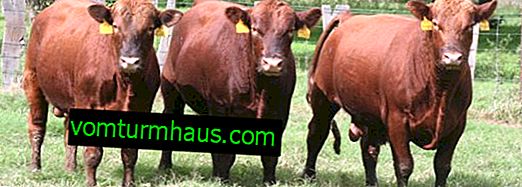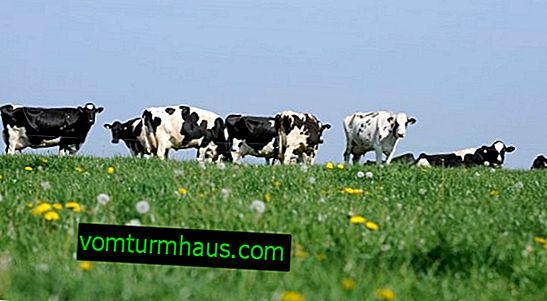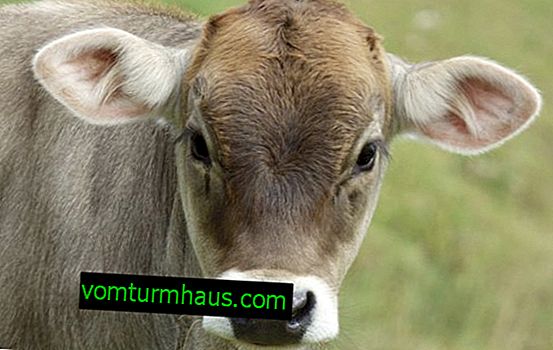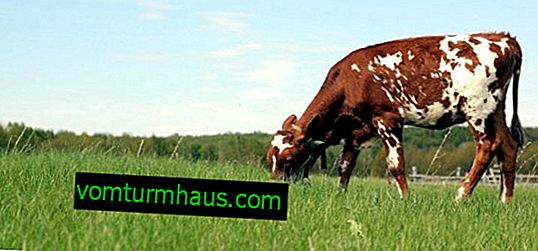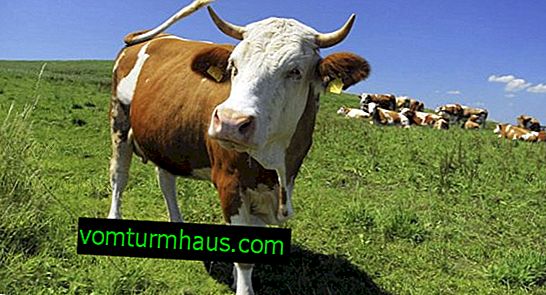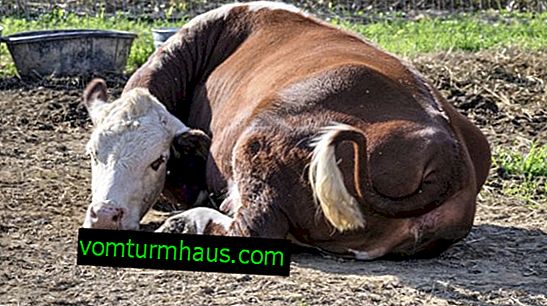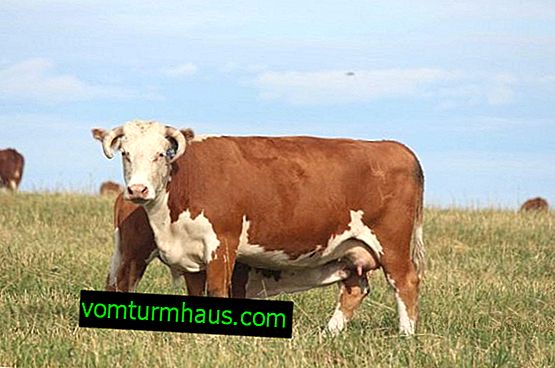A cow is an important animal in the farm. Being a sacred animal in some cultures, cows are actively used in others mainly for milk and meat. In this regard, the breeder must know not only how to take care of the cow on the farm, but also how to behave if the animal becomes ill. One of the most common and dangerous diseases is cow pox
Read MoreIn the world there are more than 1080 breeds of cattle, which are divided into meat, dairy and mixed. One of the brightest representatives of meat breeds that enjoyed great success in the post-Soviet countries is the Kazakh white-headed. It is remarkable not only for its appearance, but also for the features of breeding and maintenance
Read MoreThe peculiarity of the anatomical structure of the stomach in cows is such that they must constantly chew food, as a result of which a large load is placed on their teeth. In this article, we will consider the structural features of cattle jaws, learn how to determine the age of the teeth and their possible diseases in cows
Read MoreThe constant development and improvement of the processes of organizing animal husbandry has led to a sharp increase in milk production and an increase in the genetic potential of cattle. However, such changes affected the established types of feeding and keeping animals, which is often a source of metabolic disorders in cows
Read MoreLoss of chewing gum in cows is a symptom of a malfunctioning food processing system in the stomach. Chewing gum is the process of re-chewing coarse food, which contributes to its assimilation. Veterinarians call the causes of pathologies malnutrition, calving and pregnancy. Why do cows chew constantly
Read MoreThe Belgian breed of cows, first of all, is known for the fact that its representatives are highly developed muscles and a lot of weight. They are even often called monster cows, bodybuilder cows. Belgian blue cow is one of the three best meat breeds. What advantages it still possesses and how to properly maintain it, will be considered in this material
Read MoreThe reproductive system of cows is vulnerable and prone to many diseases, especially in the postpartum period. This is primarily due to the fact that the sensitivity of the uterus is increased, and immunity is reduced. In this regard, a disease such as endometritis is a frequent occurrence in cattle
Read MoreCows are unpretentious animals, they can eat both high-quality food, and they will not disdain food whose quality factor is in doubt. But if the owners of cattle take advantage of their undemanding, then you should not expect high rates and good health from the animal. The level of productivity and physical condition of the horned depends on the owner’s approach to their feeding and living conditions.
Read MoreEach cow owner expects his cattle to produce a lot of milk. But it happens that the milk yield does not live up to the expectations of the owner of the burenka, this is especially unpleasant when before the cow gave much more product than now. The reasons can be very diverse, and each of them needs to be understood in order to increase milk yield
Read MoreLivestock breeding is one of the oldest ways of obtaining human food. For many centuries, cattle breeding has been carried out, when animal species are divided into dairy and meat. This article is about one of the most productive dairy breeds of cows - Dutch. Breed description The Dutch cow, as its name implies, comes from the Netherlands
Read MoreThese shaggy and hornless animals quite strongly beat out from the usual image of cows. And they give milk much less than our cows. However, the excellent taste of the meat of the Hallowian breed of cows and the unpretentiousness of these animals to the conditions of feeding and feeding attract more and more close attention of livestock breeders
Read MoreBreeding cattle today is a lucrative occupation. Cattle breeders pay more attention to the meat production sector, looking for animal breeds with the highest productivity potential. Today we will talk about the Aberdeen-Angus cattle breed, its characteristics and conditions. Description and breed standard The breed was bred in the XIX century by Scottish breeders of the two counties Aberdeen and Angus
Read MoreAny animals, one way or another, are susceptible to all kinds of diseases. From some of them immunity is developed, from others, salvation has not yet been found. Such dangerous ailments include leukemia, which affects the circulatory system of animals. In our article, we will understand what leukemia is in cows, how it is transmitted, who is its causative agent, how to identify a sick individual and what measures for its treatment and isolation from a healthy livestock should be used, as well as methods of preventive measures
Read MoreThe Jersey Cow belongs to the expressed breeds of the dairy direction. Many farms prefer to keep cattle for universal use, but this breed is popular in many countries of the world due to its high milk yield and excellent milk performance (especially in terms of fat content). Consider a description of this breed, its advantages and disadvantages, as well as features of the content and feeding
Read MoreCattle breeds are divided by productive orientation. There are dairy, meat and meat and dairy breeds, which differ from each other in external characteristics and the number of products produced. This article will consider the advantages and disadvantages of the Kholmogory breed of cows, the features of their maintenance and care for them, the principles of feeding and breeding of young animals
Read MoreThere are a large number of breeds of cows, which are divided among themselves in the direction of productivity. One of the best breeds of the dairy direction is considered to be a red steppe breed, which was bred in the south of Ukraine. This article will discuss the features of the maintenance and care of the red steppe breed, the principles of its feeding, as well as the advantages and disadvantages over animals of other breeds
Read MoreSimmental cows are considered to be one of the most popular cattle breeds. For many years, these animals have been used by farmers around the world for a reason; their main feature is the perfect combination of productivity and unpretentiousness in food and conditions. But, despite this, many pastoralists do not stop their choice on this breed, considering it unprepared for existence in regions with cold winters
Read MoreUnpretentious breed with fast growth and meat of excellent quality - this is exactly the Charolais breed of meat. She has been more than two hundred years old, but she has not lost her relevance now. Consider the main characteristics of this French breed, the conditions of its maintenance and nutrition
Read MoreGrowing and raising cattle requires a special approach to their health. The period of free-walking of animals in unverified pastures increases the risk of infection with helminthiasis, especially if the animals are not taken preventive measures to combat helminths according to the scheme once every 6 months
Read MoreCow herds grazing in the meadow are an indispensable part of the village landscape. Everyone understands the importance of this animal in human everyday life, but, like people, cows are susceptible to various diseases and one of them is diarrhea. Consider why it is dangerous and what to do if this problem occurs
Read MoreEvery farmer is faced with various cattle diseases. Some are easy to diagnose, while others, on the contrary, are difficult to diagnose. Diseases can occur from mild ailment and can be fatal. Today we will talk about clostridiosis, which has not been given due attention for a long time. What is clostridiosis Clostridiosis is an infectious disease in cattle
Read MoreCattle herds are divided by productivity areas. Some animals are raised for meat, others produce large quantities of milk, and still others have a mixed direction. One of the most valuable breeds of cattle, which gives tasty meat and a lot of milk, is considered the Kostroma breed of cows. This article will discuss the features of the cows of this breed, their advantages and disadvantages, as well as the principles of feeding
Read MoreBefore you go to buy a cow, you should decide on the purpose of its acquisition and breed. Then you need to familiarize yourself with the conditions and amount of feed and make sure that you can provide all this. In the article we will tell you how to determine a good cow during a visual inspection. Types of cows in the direction All breeds of cows are divided into 3 species, depending on their direction: Lactic
Read MoreMany farmers suggest that swelling of the udder in cows after calving is quite normal, as it is a natural reaction of the body to pregnancy. Yes, the short-term presence of a slight swelling is permissible during this period. But there are other causes of swelling of the mammary glands of a cow. We will talk about the causes of edema and how to deal with it in our article
Read MoreCattle breeding, or cattle for short, people began to engage in the earliest period of human development, constantly improving the breed, depending on their needs. So, there are cows meat, dairy and universal. The latter are especially popular, and their brightest representative is Schwyz. Breed description Schwyz cows were introduced in the 14th century in the canton of the same name Schwyz, which is located in Switzerland
Read MoreThe breed of Yaroslavl cows is one of the oldest in Russia, where for many years it has been valued for its highest milk productivity and fatty nutrient yields. In our article, we will consider a detailed description of these animals and find out all the nuances of their content, nutrition and walking
Read MoreThe Holstein breed of cows has been popular among breeders for a century and a half since it was bred at the end of the 19th century. About the reasons for popularity, as well as about the features of its content, our material. Description and breed standard The Holstein cow is one of the most common dairy breeds in the world
Read MoreEveryone who has been breeding cattle with the goal of obtaining dairy products is familiar with mastitis. This diagnosis brings a lot of problems, so it is important to know how to identify it and how to cure it in order to minimize the waste of milk and money - more on this later in the article. What is mastitis in a cow One of the most common diseases in livestock farming of the dairy direction is mastitis
Read MoreEach cow has a tail with a fluffy tassel, which, as a rule, it swings from side to side. Many people wonder why the cow needs this part of the body. Let's consider it in more detail. Why a cow tail With the help of this process, cattle drives away annoying insects: flies, gadflies, mosquitoes, horseflies
Read MoreIt is very important for owners of cattle to be able to determine the pregnancy of a cow, since at this time the animal should provide competent care and a balanced diet. There are several folk methods that allow you to independently determine whether the cow is in an "interesting position"
Read MoreIn addition to keeping and caring for cattle, livestock breeders need to know how the animal’s body works. This fact-finding article talks about the structure of a cow’s skull and its features. Cow skull anatomy In the cranium of the cow there are two departments: the front and the brain. In the first section are the organs of vision, smell and taste, and in the second is the brain of the animal. 1
Read MoreThe life span of cattle depends on how much milk and offspring its owner will receive. Let us consider in more detail how to determine the age of cows and bulls, as well as how to extend the life of animals. How many years on average have cattle been living? On average, the life expectancy of cows is 17–20 years.
Read MoreKoch's wand is dangerous for cattle. One of the varieties of tuberculosis is called bullish, although bulls and cows are subject to both human and bird species of this disease. We find out what kind of disease it is, what its causes, symptoms, diagnosis and measures taken to detect tuberculosis in the herd
Read MoreIn livestock, the emergence of a new calf is important not only in terms of increasing the number of livestock, but also as a factor in increasing the productivity of dairy cows. In the postpartum period, the milk yield increases to 20–25 liters per day, and reaches its peak by the 60th day after calving, therefore it is necessary to prevent postpartum complications, which, in particular, include paresis.
Read MoreA cow has been a life companion and source of human nutrition for several thousand years, during which the breeds of this animal were clearly divided according to the benefits brought to its owner, into dairy, meat and mixed meat and dairy. The Hereford cow is a distinct representative of the meat breed, and for the entire time of its breeding the dairy "component" has never been given attention
Read MoreTo avoid losses, a modern farmer should be sufficiently aware of cattle diseases, methods of their prevention and treatment. Necrobacteriosis is a dangerous but treatable disease. Having become familiar with the symptoms and causes that are presented in the article, it is easier to identify the disease in the early stages, thereby reducing the economic damage to the economy
Read MoreReduced immunity in cattle leads to the appearance of papillomas on the udder. The growths on the skin appear as a result of pathological microorganisms entering microcracks. Neoplasms cause discomfort in the cow, which complicates the milking process, reduces the quality of products and leads to the development of complications
Read MoreHay is an essential ingredient in a cow’s diet throughout the year. However, there are times when an animal refuses to consume it. For what reasons this happens and how to get out of the situation, we will tell in the article. Feed Characterization Like any other animal, a cow needs a varied and balanced diet that will replenish the body with the necessary elements, so that it has good health and high productivity.
Read MoreThe cow has a complex digestive system, the work of which depends on many factors. For example, improper or poor-quality food can lead to a common ailment of cattle - atony of the stomach. If you do not respond in a timely manner to the manifestations of this disease, then it can result in gastric obstruction and even death of the cow
Read MoreDespite the size and strength of animals related to cattle, they are susceptible to many diseases. Especially a lot of problems appear during grazing in warm time in open areas. One of the most dangerous is the penetration of gadfly larvae under the skin. Consider what constitutes a disease and how to get rid of it
Read More










